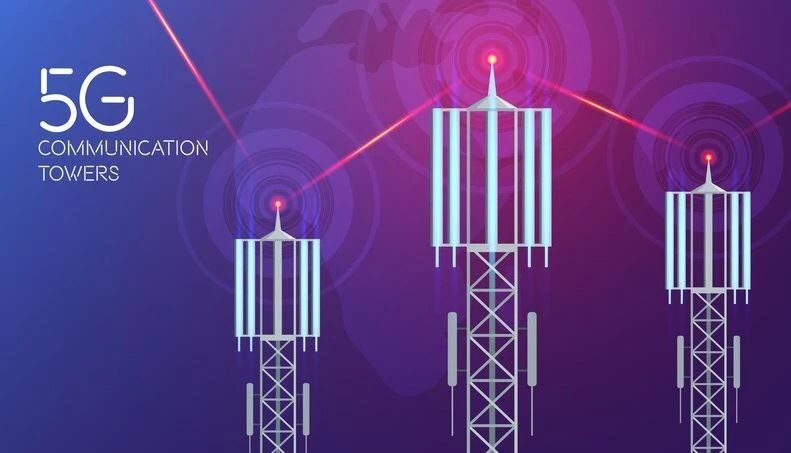Table of Content
Know How the Usage of AI in Telecom Industry is Evolving Rapidly
The impact of artificial intelligence across diverse commercial fields is becoming evident day by day. Businesses are rapidly integrating AI-powered systems into their infrastructure to automate various types of operations. Talking about the telecom sector, the usage of AI is also getting into full swing, allowing companies to simplify various critical tasks swiftly. Just like other fields, telecom also requires automation in different processes. With the help of AI-powered software development services, this task has become quite easy, in fact pretty much streamlined for the telcos working out there.
The emergence of AI has given telecom companies a leverage to resolve various types of issues. The one most important among them is the management and monitoring of data consumption. From a long time, it has remained a problem for the telecom companies to see how much data is being proliferated through the unknown channels. It has brought a great strain over their networks, forcing them to shutdown or face serious disruptions every now and then. With the help of AI-powered systems, this problem has been solved, as companies can now monitor data consumption smartly without even putting any manual effort.
Besides this case, there are countless other scenarios in which AI is proving to be a beneficial tech source for telecom companies. In this blog, we will discuss all of them, so that you can understand why AI is increasingly becoming important for the telecom industry. Let’s start from the basics understanding what is AI and how it is bringing a solid transformation impact across the global telecom circuit.
What is Artificial Intelligence?

Artificial Intelligence (AI) refers to the simulation of human intelligence in machines that are programmed to think and act like humans. This field encompasses various subfields such as machine learning, natural language processing, computer vision, robotics, and more. At its core, AI aims to enable computers to perform tasks that traditionally require human intelligence, such as understanding natural language, recognizing patterns in data, making decisions, and solving complex problems.
Machine learning, a prominent subset of AI, involves training algorithms to learn from data and make decisions without being explicitly programmed. Through iterative learning, these algorithms improve their performance over time, adapting to new data and experiences. Natural language processing (NLP) enables computers to understand and interpret human language, facilitating communication between humans and machines. Computer vision allows machines to analyze visual information from the world, enabling tasks such as image recognition, object detection, and more others.
AI has a wide range of applications across various industries, including telecom, finance, healthcare, and more. In healthcare, AI-powered systems can analyze medical images, assist in diagnosing diseases, and personalize treatment plans. In finance, AI algorithms are used for fraud detection, risk assessment, and algorithmic trading. Autonomous vehicles rely on AI for navigation, obstacle avoidance, and decision-making on the road. As AI continues to advance, it holds the potential to revolutionize countless aspects of society, improving efficiency, productivity, and quality of life.
Importance of AI in Telecom

Artificial Intelligence plays a pivotal role in transforming the telecommunications industry by enhancing network management. One of the key areas where AI is crucial is in network optimization and management. Telecommunication networks generate massive volumes of data, and AI algorithms can analyze this data in real-time to optimize network performance, predict network failures, and proactively address issues before they impact service quality. By leveraging AI-driven analytics, telecom companies can ensure better network reliability, reduce downtime, and deliver superior service to customers.
Furthermore, AI is revolutionizing customer service in the telecom industry. Chatbots powered by AI and NLP technology are increasingly being used to handle customer inquiries and streamline support processes. These chatbots can handle a wide range of customer queries efficiently, reducing the need for human intervention and enabling telecom companies to offer round-the-clock support. Additionally, AI-driven recommendation engines can analyze customer data to offer tailored product and service recommendations, enhancing customer satisfaction and driving revenue growth.
Moreover, AI enables telecom companies to innovate and offer new, value-added services to their customers. For example, AI-powered virtual assistants can provide personalized recommendations for entertainment content, such as movies, music, TV and more others. AI-driven predictive analytics can also help telecom companies anticipate customer needs and preferences, enabling targeted marketing campaigns and promotions. By harnessing the power of AI, telecom companies can stay competitive in a rapidly evolving industry landscape, drive innovation, and deliver superior experiences to their customers.
Key Benefits of AI in Telecom

Artificial intelligence can be used to simplify different types of telecommunication jobs. It is commonly used for live data consumption management, requiring no manual effort from the human administrators. Besides that, AI also offers plenty of advantages for the telecommunication circuit. If you do not know much about them, take a look at the points defined below.
System Maintenance
With the integration of AI, telecommunication operators have the capability to enact predictive maintenance strategies by delving into extensive historical datasets. This enables them to predict equipment failures and assess performance as per the latest tech trends in UAE. Through this analysis, potential issues like equipment malfunctions or signal deterioration can be identified in their nascent stages. Consequently, telecom companies can orchestrate maintenance schedules in advance, ensuring minimal downtime and maximal efficiency in resource allocation.
Moreover, AI-driven predictive maintenance not only allows for the early detection of equipment issues but also facilitates a deeper understanding of the underlying causes. By scrutinizing patterns within the data, telecom operators can discern the root causes of potential failures, whether they stem from environmental factors, usage patterns, or hardware malfunctions. This granular insight enables operators to implement targeted interventions and optimization strategies to bolster network reliability and longevity.
Network Security
As cybersecurity threats become more sophisticated and prevalent, the integration of artificial intelligence becomes indispensable in fortifying the defenses of telecommunications networks. These networks, are prime targets for malicious actors seeking to exploit vulnerabilities for various nefarious purposes. AI-driven security mechanisms stand at the forefront of this ongoing battle, leveraging advanced algorithms to scrutinize network traffic in real-time. This allows for the swift identification of anomalous patterns or behaviors indicative of potential threats.
Furthermore, the deployment of AI in telecom network security not only bolsters defense mechanisms but also revolutionizes the approach to threat detection and response. Traditional mobile app security approaches often rely on reactive measures, which may prove inadequate against rapidly evolving cyber threats. In contrast, AI-driven systems offer a proactive defense posture by autonomously detecting and mitigating risks in real-time. Through the analysis of vast amounts of network data, AI can uncover subtle indicators of potential breaches or intrusions that may elude conventional detection methods.
Better Customer Support
The integration of AI-driven chatbots and virtual assistants marks a significant paradigm shift in the realm of customer service within the telecom sector. These sophisticated systems represent a convergence of cutting-edge technologies, enabling them to tackle a diverse array of customer inquiries with unprecedented efficiency and accuracy. From basic account management tasks to complex technical support issues, these intelligent assistants adeptly navigate through queries, offering instantaneous responses tailored to individual customer needs.
Moreover, beyond their capacity to provide instantaneous support, AI-driven customer service solutions offer unparalleled convenience and accessibility by operating round the clock. This 24/7 availability not only meets the expectations of today’s digitally connected consumers but also establishes a crucial competitive edge for telecom companies in a rapidly evolving market landscape. By automating routine inquiries, these intelligent systems not only alleviate the burden on human customer service agents but also foster greater customer loyalty through consistently efficient and responsive assistance.
Organized Network Management
Through the utilization of AI algorithms, telecom enterprises can delve into immense volumes of network data in real-time, thereby unlocking a spectrum of capabilities aimed at enhancing network performance. This sophisticated integration empowers telecom companies with the ability to not only optimize network functionality but also anticipate and mitigate potential issues before they escalate. The continuous monitoring of network traffic facilitated by AI enables the discernment of intricate patterns, furnishing telecom operators with invaluable insights for refined resource allocation.
Furthermore, the deployment of AI algorithms in network management transcends mere reactive troubleshooting, ushering in an era of proactive and predictive network maintenance strategies. By extrapolating insights from real-time data analysis, AI empowers telecom companies to forecast potential bottlenecks or vulnerabilities, enabling preemptive measures to be implemented proactively. This predictive capability not only minimizes the likelihood of service disruptions but also enhances overall network resilience and reliability.
Resource Optimization
Utilizing AI-driven optimization methodologies, telecommunication firms can achieve unparalleled efficiency in managing their diverse resources. These advanced AI techniques enable telecom companies to fine-tune network performance, simultaneously curbing operational expenses by dynamically reallocating resources in response to shifting demand dynamics. By harnessing AI innovations, telecom operators can adeptly navigate the escalating demands for high-speed connectivity and bandwidth-hungry applications.
Moreover, the integration of AI-driven optimization strategies transcends conventional resource management paradigms, fostering a holistic approach that not only optimizes network efficiency but also augments service quality and user experience. By leveraging AI algorithms to discern intricate patterns within network traffic and demand fluctuations, telecom companies can orchestrate resource allocation strategies with unparalleled precision and foresight. This granular level of control not only enhances the performance of telecom networks but also cultivates an environment conducive to innovation and growth.
Important Use Cases of AI in Telecom

The use cases of AI in telecom are countless, meaning that the technology can be used by the telcos at a number of places easily. It has the power to transform processes, allowing companies to automate and execute several tasks in a blink of an eye. If you do not know the areas where AI can be used in telecom perfectly, take a look at the key use cases given below.
Virtual Assistance
AI-driven virtual assistants have emerged as indispensable assets within the telecom industry, adeptly managing a myriad of customer inquiries while tailoring support experiences to individual needs. These sophisticated digital entities harness the power of artificial intelligence to not only handle diverse customer queries but also to personalize interactions, thereby fostering a deeper sense of engagement and satisfaction among users.
The perpetual availability of AI-driven virtual assistants not only enhances the accessibility of customer support but also elevates the responsiveness of telecom companies. By operating 24/7, these virtual assistants embody a paradigm shift in customer service, ensuring that assistance is readily available whenever and wherever customers require it. This seamless accessibility not only enhances trust, but also enables telecom companies to stay ahead of the curve in an era defined by heightened customer expectations.
Automated Billing
Telecom billing systems leverage the capabilities of AI to meticulously analyze usage patterns, swiftly identify discrepancies, and generate precise invoices in real-time. Through the application of advanced algorithms, these systems delve into vast datasets to discern intricate usage trends, ensuring that customers are billed accurately for the services they consume. Furthermore, by automating key billing processes, AI-driven systems streamline operations, mitigating the risks associated with manual errors and inefficiencies.
Moreover, beyond merely improving billing accuracy, AI-powered telecom billing systems contribute to greater transparency and trust between service providers and customers. By offering real-time insights into usage patterns, these systems empower customers with a comprehensive understanding of their expenditures and service usage. Additionally, the automation of billing processes ensures consistency and reliability, reducing the likelihood of billing discrepancies and disputes.
Churn Analysis
Churn prediction stands as a critical application of AI within the telecommunications sector. This predictive analytics methodology relies on AI algorithms that meticulously scrutinize a multitude of factors, including but not limited to usage patterns, historical billing data, and customer engagement metrics. By harnessing these diverse datasets, AI-driven churn prediction systems are capable of generating nuanced insights into individual subscriber behavior, enabling telecom operators to proactively identify and address potential churn risks before they materialize.
The intricate analysis conducted by AI algorithms not only enables telecom companies to predict churn probabilities with a high degree of accuracy but also facilitates the customization of retention strategies tailored to the unique needs and preferences of individual subscribers. Through the identification of key indicators indicative of churn propensity, such as fluctuations in usage patterns or declining levels of engagement, AI-powered systems empower telecom operators to deploy targeted interventions aimed at preserving customer loyalty and mitigating attrition.
Real World Examples of AI in Telecom

Many telecom companies are already using AI to speed up various processes. They are using the power of artificial intelligence to automate several operations that are quite complex and detailed. Here are some of the best examples of telecom companies that are leveraging the power of AI to streamline different processes.
China Mobile
Utilizing AI technologies, China Mobile, the world’s largest telecommunications company, enhances network efficiency, addresses traffic congestion, and extracts valuable insights from customer data. Employing AI algorithms, the company focuses on network planning and optimization, customer segmentation, and predictive maintenance strategies. Additionally, China Mobile provides AI-powered services including virtual assistants and personalized content recommendations, aiming to enrich the overall customer experience.
Vodafone
Vodafone, among the globe’s premier telecommunications enterprises, integrates AI technologies to elevate network performance, refine resource management, and tailor customer interactions. The company leverages AI-driven predictive analytics for preemptive network upkeep, employs AI-powered chatbots to enhance customer support services, and harnesses machine learning algorithms to refine the precision of targeted marketing initiatives.
AT&T Mobile
AT&T, a prominent telecommunications provider in the United States, incorporates AI throughout its network infrastructure and customer-centric offerings. The company utilizes AI for network enhancement, predictive maintenance, and detecting fraudulent activities. Additionally, AT&T provides AI-driven virtual assistants, aiming to elevate customer interactions and satisfaction levels.
Frequently Asked Questions
| Why AI is important for the telecom sector? AI is crucial for the telecom sector as it enhances network efficiency, predicts customer behavior, and improves service quality through automation and data analysis. |
| How AI can help in generating automated bills for a telecom company? AI enables telecom companies to automate bill generation by analyzing usage patterns, and identifying discrepancies. It is capable to regularly track data consumption, and generate customer bills according to that. |
| Which telecom companies are using AI to transform operations? Many telecom companies in the world are using AI to automate different critical functions. Some of the top names among them includes Vodafone, China Mobile, AT&T and more others. |
Final Words
That brings us to the end of this blog in which we have discussed how AI is transforming the telecom sector massively. Many people think that AI is only beneficial for the IT industry. Well, this is certainly not a right understanding because AI has brought great advantages for other fields as well. Telecom is one of those sectors where AI has transformed various processes. This blog has discussed some of them to let you know how AI in telecom is evolving day by day. It has allowed telcos to swiftly automate various critical processes that once required huge resources and budget to get completed.

Empower your digital journey with StruqtIO - Your dedicated partner for cutting-edge custom software development, innovation, and digital transformative solutions. Harness the power of technology to elevate your business and redefine your digital landscape today.


